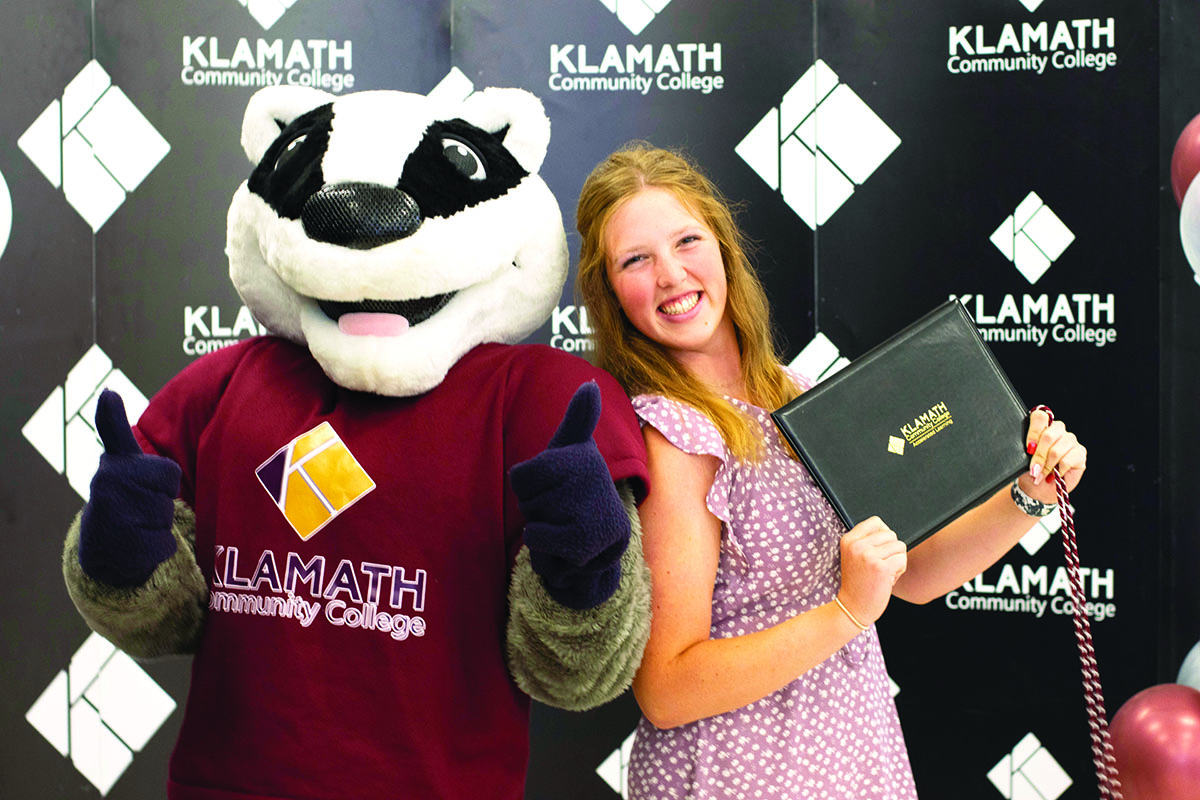School districts work with Klamath Community College, Oregon Tech to help high school students earn college credits

- Community
- Academic
Accelerated Learning benefits
For high school students in the Klamath Basin, there’s an opportunity to earn extra credit.
As in college course credits.
Dual enrollment (i.e. dual credit) programs are offered by local school districts who partner with Klamath Community College and Oregon Tech.ner
Jeff Bullock, secondary programs director, with the Klamath County School District, said the programs are very popular with students because they can earn college credits for free through Klamath Community College and for $25 per credit via Oregon Tech.
The latter is through the College Now program. Bullock said KCSD picks up students’ tabs for those classes.
“My office pays the costs of tuition and the cost of books,” he said, estimating the annual cost at approximately $30,000 with state grants helping absorb costs.
He said students earn college credits in a variety of courses including writing, math (pre-calculus and calculus) as well as various science courses.
Bullock said KCSD teachers can get approved to teach college level courses in two ways.
“It really boils down to two pieces — a master’s degree on the content area for the course or they can also be approved based on experience,” Bullock said.
KCC offered college courses to more than 1,800 local high school students during the 2023-24 school year — free of charge, according to the school.
That saves them as much as $100 to $300. Out-state-students are charged $25 per credit.
KCC President Roberto Gutierrez said he views the dual credit program as “doing the right thing” for local high school students and the community.
“Dual credit courses give students, who may not otherwise have the opportunity, a chance to earn college credit — free of charge — and experience a curriculum that prepares them for the rigors of higher education,” he said.
Gutierrez said dual credit courses help give high school students experience at the college level.
“Being prepared for college not only saves the student money, but taxpayers, too,” Dr. Gutierrez said.
“These students have earned transferable college credit which will save them significant expense for college education,” Gutierrez said. “As we know, student debt is the number one thing keeping students from attending college.”
High school teachers are vetted and deemed qualified to teach specific courses.
According to KCC, 1,827 students from 27 different high schools participated in dual credit courses last school year. Sixty percent of them were female and more than 22 Hispanics, according to KCC.
“This program has been 10 years in the making, from the early days of Klamath Promise,” Gutierrez said. “We believed that given the poor high school graduation rates, it was best to give students the opportunity to see that attending college can lead to a better life.”
KCC currently offers 65 courses where high school students can earn credit including in writing, English literature, biology, chemistry, economics, geology and Spanish.
That includes six digital media classes offered at Klamath Union High School.
Karla Andrade, Klamath Union’s college and career coordinator, said during the last school year 166 KU students received college credits from Southern Oregon University in courses such as American history, world civilizations and literature. She said students also earned KCC credits in photography, videography, media design and health.
“KU has two different programs where students are eligible to take college classes for credit during their high school career,” she said.
“Those programs are KCC Pathways and the Liberal Arts Academy. The KCC Pathways program is where eligible juniors and seniors take classes in a field they are interested in (Welding, Nursing, Early Childhood education, etc),” Andrade said.
The Liberal Arts Academy entails seniors taking economic, writing, anthropology, sociology and humanities classes where they can earn up to 20-24 college credits.
“When it comes to dual credits, one of the most popular classes are the Digital Media classes taught by Dan Stearns. THe students love learning about all of that stuff. Students are really happy they have the option to earn college level credits in the other programs because they know that saves them more money in the long run,” Andrade said.
Carleen Drago, director of educational partnerships and outreach with Oregon Tech, said the university looks to help Klamath County and Klamath Union district students earn college credits that can help them on their higher education and career paths.
“We’d love students to matriculate at Oregon Tech,” she said.
But Drago said she realizes not all students on that path and dual enrollment efforts aim to help them build up credits they can use at other college and universities.
“We really focus on lower division credits that are the most transferrable,” said Drago.
She said more than 400 students between the two local districts earned credits at Oregon Tech last school year.
Some classes are offered at a flat $100 rate and lower-income students can get fees waived, Drago said.
Drago said the goal is to offer more opportunities.
“I think we are always looking at ways to work with the high schools for more opportunities to engage with students,” she said.
